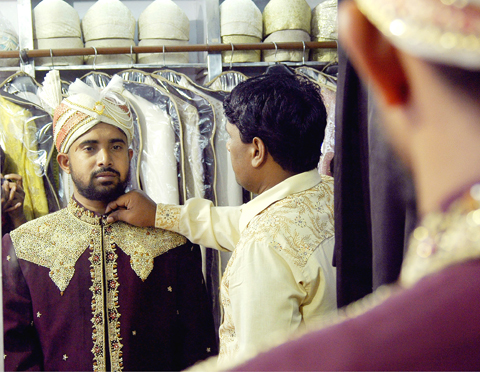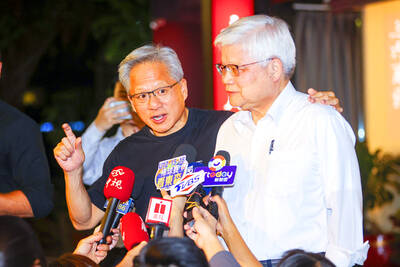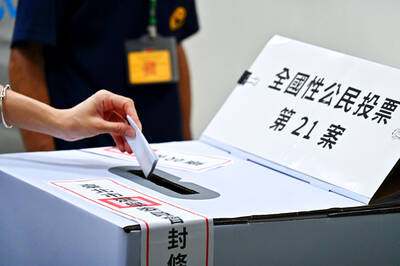Preeti Punamiya is a young and excited bride-to-be, preparing to get married in a traditional Indian wedding, which usually features days of lavish celebrations.
The impact of the global economic downturn, however, has caused her to rethink the extravagance, following a trend that has seen many Indian families scale down their celebrations over the past 12 months.
“It’s our families who wanted to make it a grand affair,” said Punamiya, a biotechnology researcher in her early 20s who is marrying a US-based software engineer.

PHOTO: AFP
“I have wanted it simple, keeping costs under check,” said Punamiya, who has cut back the days of festivities to three from the five customary in her family and also slashed the number of ceremonies to three from nine.
India’s wedding seasons from mid-October to January and April to July bring with them street drummers and musicians, processions and open-air ceremonies where the statement often seems to be: The bigger and louder the better.
The industry is estimated to be worth 1.25 trillion rupees (US$27 billion) a year. One leading wedding Web site, Shaadi.com, put the average cost of a high-end marriage at US$44,000.
Wedding planners say, however, that as the effect of the worldwide recession hits exports, imports and the service industry, India’s wealthier urban upper classes are cutting back on costs.
“People are curbing expenses,” said Tejal Kadakia, who founded Knot Forever, a Mumbai-based wedding management firm. “For Indians, a wedding is a one-time event. People want a stylish, quality event, but they are trimming catering costs and even those on the guest list.”
A traditional Asian wedding is lengthy and elaborate, starting with a trip to the astrologer or family priest who chooses the auspicious day and time of the ceremony considering phases of the moon.
Rings are exchanged at the engagement, followed by the mehndi ceremony, where the bride’s arms and legs are intricately painted with brown henna dye to ward off evil and strengthen love.
The next day sees an elaborate sangeet — a musical, dance or even Bollywood-style extravaganza. The wedding itself usually comes 24 hours later, followed by cocktails and a lavish evening meal.
Moroccan — or Turkish-style weddings — with billowing tents, vast pavilions, hookah smoking pipes and finely-upholstered, low-slung divans — have proved popular with expatriate Indians who travel home to tie the knot.
However, Tejal said, “these themes are vanishing. People prefer Rajasthani or Luckhnowi themes which are traditional and cheaper.”
“Until three years back there was a certain childishness, an urge to show wealth. That has gone. Now it is not who beats whom. I would say we all seem to have been beaten by recession,” he said.
Candice Pereira, creative head of “Marry Me” wedding consultants, said: “Some people do prefer to combine the mehndi and sangeet events.”
Tejal also said families were choosing to skip the music and dance altogether.
“Earlier there was a demand for only well-known singers or bands,” she said. “The musical event is becoming optional or is personally choreographed. A lively family dance is considered enough.”
Nevertheless, Bollywood song-and-dance events remain hugely popular with overseas Indians, particularly those from the US and Canada.
Compared with many Western countries, wedding planners like Tejal and Pereira, whose firm charges upward of 1 million rupees per event, are a new breed in India.
Wedding management firms have mushroomed in recent years across India’s big cities, attracting clientele from medical doctors like Punamiya’s family to industrialists and construction firm bosses.
This year, however, Tejal said she has organized weddings for just six to eight clients, compared with 10 to 12 in 2008.
Many overseas-based Indians or people of Indian origin choose to get married in India because of cheaper costs and its cultural significance. Overseas, the cost of hiring venues, catering and ethnic Indian wedding wear quickly adds up.
India’s salaried urban middle classes are also learning to streamline costs amid concern for their jobs.
One recently married Mumbai media consultant who asked not to be identified said he had been under pressure to have a traditional “multi-function” marriage — but was conscious of the cost.
“At one point I considered a court [civil] marriage, but the process is complex,” he said. “We finally did a two-day event, skipping the mehndi and sangeet.”
The couple printed few cards, sending out most invitations on e-mail or through mobile phone text messages.
“My honeymoon will have to wait. I had to be back at work,” he said.

CHAMPIONS: President Lai congratulated the players’ outstanding performance, cheering them for marking a new milestone in the nation’s baseball history Taiwan on Sunday won their first Little League Baseball World Series (LLBWS) title in 29 years, as Taipei’s Dong Yuan Elementary School defeated a team from Las Vegas 7-0 in the championship game in South Williamsport, Pennsylvania. It was Taiwan’s first championship in the annual tournament since 1996, ending a nearly three-decade drought. “It has been a very long time ... and we finally made it,” Taiwan manager Lai Min-nan (賴敏男) said after the game. Lai said he last managed a Dong Yuan team in at the South Williamsport in 2015, when they were eliminated after four games. “There is

Chinese Nationalist Party (KMT) lawmakers have declared they survived recall votes to remove them from office today, although official results are still pending as the vote counting continues. Although final tallies from the Central Election Commission (CEC) are still pending, preliminary results indicate that the recall campaigns against all seven KMT lawmakers have fallen short. As of 6:10 pm, Taichung Legislators Yen Kuan-heng (顏寬恒) and Yang Chiung-ying (楊瓊瓔), Hsinchu County Legislator Lin Szu-ming (林思銘), Nantou County Legislator Ma Wen-chun (馬文君) and New Taipei City Legislator Lo Ming-tsai (羅明才) had all announced they

Nvidia Corp CEO Jensen Huang (黃仁勳) yesterday visited Taiwan Semiconductor Manufacturing Co (TSMC, 台積電), as the chipmaker prepares for volume production of Nvidia’s next-generation artificial intelligence (AI) chips. It was Huang’s third trip to Taiwan this year, indicating that Nvidia’s supply chain is deeply connected to Taiwan. Its partners also include packager Siliconware Precision Industries Co (矽品精密) and server makers Hon Hai Precision Industry Co (鴻海精密) and Quanta Computer Inc (廣達). “My main purpose is to visit TSMC,” Huang said yesterday. “As you know, we have next-generation architecture called Rubin. Rubin is very advanced. We have now taped out six brand new

POWER PLANT POLL: The TPP said the number of ‘yes’ votes showed that the energy policy should be corrected, and the KMT said the result was a win for the people’s voice The government does not rule out advanced nuclear energy generation if it meets the government’s three prerequisites, President William Lai (賴清德) said last night after the number of votes in favor of restarting a nuclear power plant outnumbered the “no” votes in a referendum yesterday. The referendum failed to pass, despite getting more “yes” votes, as the Referendum Act (公民投票法) states that the vote would only pass if the votes in favor account for more than one-fourth of the total number of eligible voters and outnumber the opposing votes. Yesterday’s referendum question was: “Do you agree that the Ma-anshan Nuclear Power Plant